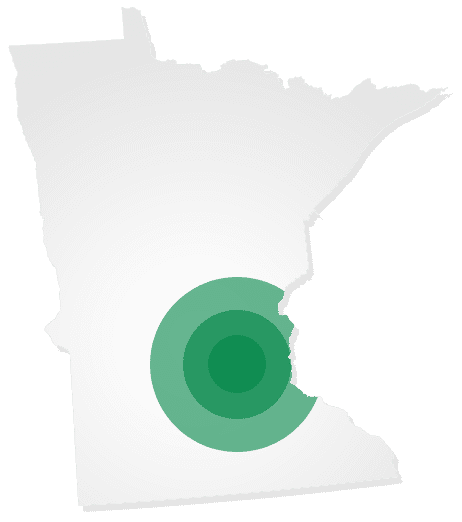Lawn Sprinkler Systems 101
Lawn Sprinkler Systems 101
Watering your landscapes uses a third of the water in our urban and suburban residential and commercial areas. That comes to about nine billion gallons of water a day in the United States. As drought becomes more frequent and more severe, landowners must water as efficiently as possible. If you’re thinking about watering more efficiently so save water (and money), we’ve created a lawn sprinkler systems 101 for you to learn everything you need know.
Benefits of Lawn Sprinkler Systems
A properly installed lawn sprinkler system can save a lot of water over a movable sprinkler on the end of a hose. A shocking half of the water used to irrigate landscapes is wasted due to evaporation, overwatering, and run-off. That represents a lot of money and a lot of wasted water.
Installing an efficient lawn sprinkler system with a WaterSense weather-based controller can save the average residential home 7,600 gallons a year. WaterSense soil-moisture-based controllers can save the average residential home 15,000 gallons a year. Commercial buildings may save even more. The Environmental Protection Agency (EPA) has a whole webpage about WaterSense controllers for home and commercial use.
Getting Started
Before you can start choosing components, you need to know how much water pressure you have in your household system. This will help dictate what components you can use.
To begin, you will need to acquire a pounds per square inch (psi) gauge that will be screwed into your hose spigot to measure water pressure. Put it on and turn the spigot wide open – write down that number and keep it handy. Next make a scale drawing of your property to get an idea of the plants and lawn areas you need to water.
Sprinkler System Components
Next, you will need to choose the components for your sprinkler system. It is best to stick with one brand of products, as they work together better than mixing and matching from different manufacturers. This article will discuss each component of the system. The components are:
- Shutoff Valve
- Backflow Preventer
- PVC Pipe
- Main Line
- Valves
- Zone Lines
- Heads
- Rain Sensor
- Controller
Getting Water to the Landscape
Your water runs from your meter to your house or office building. You will need to install the main irrigation line off of that line to water your landscape. Place a shutoff valve between the line from the meter and the main irrigation line. If you have a leak or other problem with the irrigation, you can shut off water to it without having to shut off water to the building. Immediately after the shut-off valve, you need a backflow preventer. This prevents water from the irrigation system from contaminating the water to the building. Now lay your main line of ¾ inch PVC. It usually runs parallel to the water line from the street.
Zones are groupings of plants or areas that need about the same amount and interval of water. You would not put a flower bed and a tree in a zone together because one needs frequent watering and the other needs less frequent watering, but much more water when it does get watered. You have to run enough zone lines so that the sprinkler heads at the end of the zone still get enough water pressure to operate properly. Using your map, look and see where you can put zone lines so they connect groups of sprinklers and do the least damage to the landscape when burying them.
Valves Control Zone Lines
Between the main irrigation line and the zone line, you put a valve. When the controller orders the valve to open, it will do so to allow the zone line to fill up with water and run the sprinklers. Valves are usually buried underground in a valve box, not unlike your meter box. This protects them but allows you access to them if you need it. Generally, two valves fit in each box. Make sure that the same brand of fixture is used on a particular valve.
Operating Pressure
Operating pressure is the psi that it takes to make a sprinkler or emitter work. Each sprinkler head has the amount of psi they require to operate. So does each pop-up valve. In general, you need 30 psi to operate a sprinkler system. If your pressure is more than 45 psi, you will need to install a pressure-reducing valve to keep the system from blowing apart.
Drip emitters need 20 psi to work but the emitters pop out at 30 psi, so you will have to use one of those pressure reducing valves on those zones. As a general rule, the psi to a given sprinkler needs to be at least the number of feet it needs to spray, measured as its radius. The sprinklers need to spray from one sprinkler head to the next sprinkler head.
Choosing Sprinkler Heads
The sprinkler heads distribute the water to the plants. Sprinkler heads come in two basic types. The type you choose will depend on your soil, water pressure, and budget. It will also depend on how easy it is to water a given space and how much water your plants need. Both types of heads are available in pop-up-type sprinklers. Fixed sprinklers are up all the time. They often get mowed over and need to be replaced. They are also a trip hazard.
Pop-up sprinklers go up when the water pressure comes on and they go down into a ground-level box when not in use. They can be mowed over safely and will not trip someone. This is very important for everyone but is a big concern for commercial buildings. If someone trips over a sprinkler head and gets hurt, your business is liable and may get sued. At the very least, you will have to pay the medical bills for the injured person.
Rotary Sprinkler Heads
Rotary sprinkler heads rotate along a fixed arc to distribute water. They are ideal for watering a large area. Although rotary sprinklers can, in theory, work as far as 65 ft., things start to go wrong with them if they are set for over 55 ft. The small residential rotors work best at 25-35 ft.
The water pressure at the rotor must exceed the distance between the rotors. There are two types of rotary sprinkler heads: impact rotors and turbine and gear-driven rotors. Impact rotors move back and forth by hitting the spray of the sprinkler. They are very noisy. Turbine and gear-driven rotors spray one or more streams of water across the landscape quietly and reliably. The back and forth gives the water a chance to soak in between blasts. Rotary sprinklers generally deliver less than one inch of water an hour.
Spray Nozzle Heads
Spray nozzle heads spray a fixed pattern. They have an amazing array of patterns available to accommodate almost any need. They even have a rotary nozzle, although it does not reach as far as rotary sprinkler heads. Spray nozzles are good for small areas and irregularly shaped areas. Spray nozzles need to be placed relatively close together. Rotary nozzles are more efficient as they do not lose so much to evaporation as the fan patterns. A spray system delivers an average of 1.5 inches per hour. It is good for flat areas and absorbent soil.
Drip Irrigation Emitters
Flower beds, shrubs, trees, container plants, and vegetable beds can be watered with drip irrigation. The emitters come in a variety of throw patterns and flow rates. They apply water right to the root zones so do not lose as much water to evaporation as sprinkler heads do. Bubblers are a type of emitter that is used to water shrubs with a flood of water. Other emitters drip at various rates, from very slow to faster. The slower emitters are usually covered with mulch, so no pipe is visible.
The Controller
The controller is the brain of the irrigation system. It tells different zones valves when to come on and when to shut off. It is generally located in a secure location. The garage, basement, or machine room are common locations. When you buy the controller, make sure it can handle the number of zones your landscape needs.
For large commercial landscapes, you will require a controller with more zones, and a higher cost, than for a residential lot.
WaterSense weather controllers come on when the weather is good and stop irrigation if it is raining. WaterSense soil moisture controllers measure the soil moisture and only come on when it is dry. These cost a little more but save a lot of water. While there are currently no state or federal rebates for WaterSense irrigation controllers in Minnesota, some local water utilities offer their customers a rebate. It makes sense to buy these types of controllers since they will save you the additional cost many times over in lower water bills.
Putting It All Together
There are a few things you need to do right before you install your irrigation system. Some places require a permit to install an irrigation system. You will need to call the city to get one. In addition, you will need to call 811 and have all the utilities marked to avoid damaging them. If you damage them, you must pay for the damage to have them repaired and any associated problems that cause. In addition, only a certified irrigation specialist may run pipes across utilities.
When you get your system together, you will need to dig trenches that are below the depth of frost and are at least 6-8 inches below the soil line. You will need to rent a special tool to go under hardscapes such as your sidewalk.
Get Professional Help
Designing and installing an irrigation system is a lot of work. All Metro Services can help. Our certified irrigation specialists will help determine the zones in your yard, choose the correct sprinkler head for each plant area, install the system while following any city or county rules, and make sure it will work for many years. We will also service all the components of that system should they need it. Contact All Metro Services today and get the best irrigation system for your landscape.
Looking for more information?
Call us today at 763-789-4788 to receive a free estimate on any of our property services.
Free Estimates
on all Services
Use the form below to request a free estimate on any of our services.






